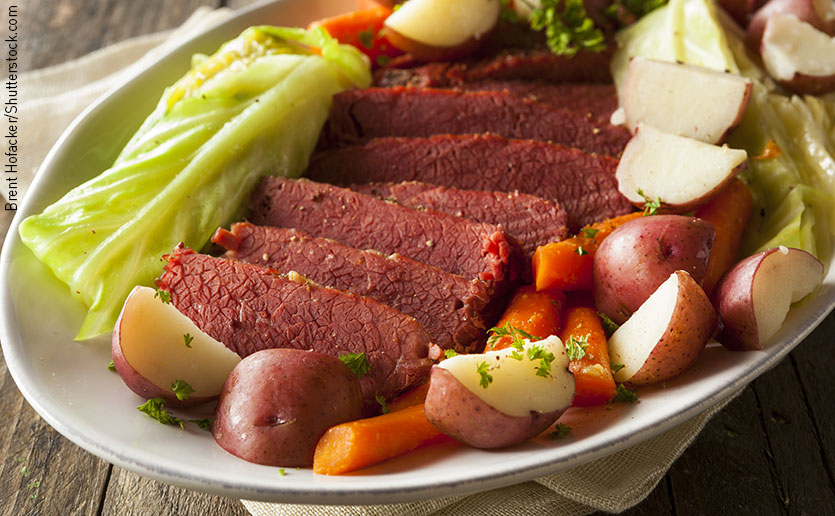Key Takeaways
March 17 isn’t just about green beer. In fact, there’s insight to be gained from a St. Patrick’s Day boiled dinner. Here’s how to use your Paddy’s Day fare to inspire future meals.
Since boiled dinners often contain three types of vegetables — cabbage, carrots, and potatoes — you’re already off to a good start. The recently released Dietary Guidelines for 2020–2025 recommend most Americans aim to eat two to three cups of vegetables daily and about 90% of us still need help meeting this goal.
If you eat your potato with the skin intact, you’ll also get roughly 40% more fiber compared to its peeled counterpart.
Improving Cancer Survival
Let’s start with the cabbage. Research indicates eating the equivalent of at least one cup per day of cruciferous vegetables, like cabbage, can be especially beneficial. Some studies show regularly consuming these vegetables may improve cancer survival and reduce risk of early death from chronic diseases, like heart disease. Other options include kale, Brussels sprouts, turnips, and broccoli. (Need a fresh idea? Make this kale pesto in advance, for a quick cruciferous-centered dinner on another night.)
Veggies to Help Your Immune System
Carrots represent another important group too. Americans have a particularly difficult time eating enough red and orange vegetables. These vegetables contain carotenoids, protective plant pigments that help keep your immune system working properly. Diets high in foods with these compounds are also associated with reduced risk of heart disease and cancer. Other vegetables to consider include winter squashes (the ones with an orange hue), pumpkin, peppers, and sweet potatoes. (Try this roasted carrot soup to further boost your carotenoid intake.)
Things to Love About Spuds
Which brings us to the often-maligned white potato. Our health is impacted by our overall diet, not by any one food. For the potatophiles out there, fear not, there are things to love about spuds too. They contain potassium, a mineral associated with reduced stroke risk, and are a good source of immune-supportive vitamin C. If you eat your potato with the skin intact, you’ll also get roughly 40% more fiber compared to its peeled counterpart (you’ll ingest more minerals too).
Beef in Moderation
As for the corned beef? It’s hard to make a convincing argument on its health benefits. Try to stick to a 3-ounce serving, which is roughly the size of a deck of cards. Corned beef is high in sodium and even a modest portion still consumes 40% to 50% of the recommended daily limit for most Americans.
And if you are having a beer to celebrate the day, the dark brews popular on St. Patrick’s Day may be a smart choice.
This is yet another reason why vegetables are so important. Diets high in potassium-containing foods, like vegetables, can act as a foil to sodium. Potassium-rich produce counteracts salt by helping to keep blood vessels open and assists in the removal of sodium from the body. So, aim to fill half your plate with vegetables, whenever possible.
The Scoop on Beer
And if you are having a beer to celebrate the day, the dark brews popular on St. Patrick’s Day may be a smart choice. It’s a far cry to say that beer is a health food, though moderate amounts (up to 1 drik per day) are associated with a lower risk of early death. Though this is not a reason to start drinking, as even modest alcohol intakes can come with risks, like increased cancer.
Despite their association with being rich and heavy, dark beers can actually be relatively low in alcohol (around 4% alcohol by volume) and may contain more phenolic compounds (chemicals in plants that may offer disease-protection) than their lighter-colored counterparts. As for that green beer? You’re better off showcasing your St. Patrick’s Day spirit with some green-hued vegetables.
Sláinte!

Emily Gelsomin, MLA, RD, LDN, is a senior clinical nutrition specialist at Massachusetts General Hospital. As a registered dietitian, she counsels on medical nutrition therapy on an outpatient basis and is co-director of Be Fit, the hospital’s employee wellness program.
Jointly sponsored by The Clubs at Charles River Park and MGH Nutrition and Food Services, the 10-week program focuses on helping participants “Be Fit and Eat Right.” Every ten weeks, employees from different departments within the hospital compete with each other as they make a commitment to Be Fit. Through the creation of a social environment at the workplace, participants are supported to make progress in personal lifestyle changes with the help of a unique support system that includes a dedicated nutritionist and personal trainer.
Be Fit strives to create a milieu of wellness that extends beyond the 10-week curriculum by offering features to those who are not part of the intensive program. This includes the creation of Choose Well, Eat Well, a rating system designed to help both employees and patients increase awareness of healthy choices at retail eateries within the hospital. They also publish a timely nutrition tip each month.






